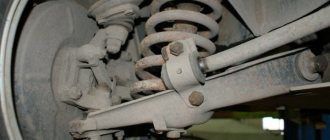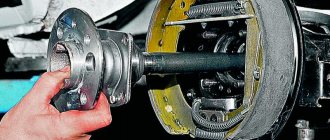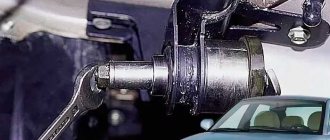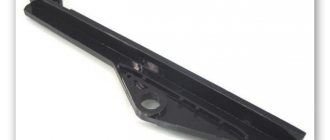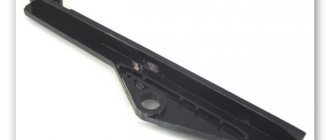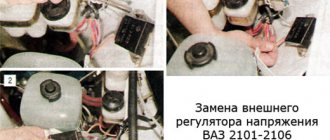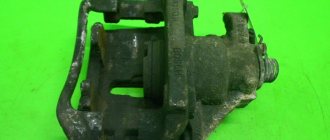Algorithm for replacing the front springs of a VAZ 2107
Prepare the simplest tool for the job; every car owner who at least sometimes repairs his iron horse should have it.
You will need:
- A set of keys (you should have it in your trunk);
- jack;
- a brush with metal bristles;
- wheel wrench;
- hammer;
- wire hook;
- mount;
- insulating tape.
The sequence for replacing the front springs is as follows:
1. Remove the shock absorber from the desired side and remove the wheel.
2. Next, you need to slightly unscrew the nuts securing the lower arm.
Place a lifting device under the lower arm and lighten the suspension (this is necessary to simplify the task of removing the stabilizer).
3. Unscrew the pair of nuts that hold the fixing bracket on the stabilizer pad.
4. Now remove the retaining bracket from its place, and then the cushion (stabilizer bushing).
5. Slightly loosen the ball nut that secures the steering knuckle and the lower hinge pin. Be careful. The nut must be unscrewed until it coincides with the end of the pin. Once this happens, lower the jack that is located under the lower control arm slightly.
6. Take a hammer and make several strong (and most importantly, sharp) blows to the outer part of the fist. Thanks to this action, you will achieve the release of the pin from the rotary cam.
7
Pay attention to the lower arm. At the moment when the pin is knocked out it will be on only one nut, you need to slightly raise the jack under the lower part of the lever
But there is no need to heavily load the suspension.
8. Unscrew the pin nut and lower the lower part of the lever as low as possible. Then, using a mounting tool, move the stabilizer (more precisely, its rod) over the stud. Now remove the jack and let the lever lower.
9. Take and make a hook out of wire and secure the upper lever with it. Please note that in this case there is no need to disconnect the steering knuckle. Try to mount the lever so that it is as high as possible - this will simplify access to the spring.
10. Pry the spring from below and pull it out from the bottom. There is a rubber spacer on the upper part of the support located on the body; remove it. If it is badly cracked, replace it. Now you have an idea of how to remove the front springs on a VAZ 2107.
Worth reading:
- Using a rope or wire, pull the upper arm higher, thereby providing access to the front suspension spring.
- Use a pry bar to pry the lower end of the spring and remove it from the lower arm support cup.
Rear axle gearbox shank oil seal: how to replace video AvtoNovator
How to install a window regulator on a VAZ 2107 on your own
The rear axle gearbox shank oil seal is a seal located on the inside of the axle bearing. Like any oil seal, its main function is to create a seal, or rather, it prevents the leakage of transmission oil, which is located in the rear axle.
The main function of the gearbox oil seal
If depressurization occurs, then all the grease in the bearings is incredibly quickly washed out, and, as a result, they are destroyed. The main sign that the gearbox seal needs to be changed urgently is an oil leak. It is quite easy to detect this; a simple visual inspection is enough: if drops of oil are found on the surface of the gearbox housing, then you cannot hesitate. However, it should be taken into account that a thin oily film does not at all indicate the presence of a leak and is in no way a reason for carrying out repair work.
Please note that it is not always possible to limit yourself to just replacing the oil seal, since quite often it is also necessary to repair the gearbox, and this is best left to professionals. Despite the fact that replacing the rear axle gearbox seal is a rather responsible procedure that requires patience and attention, this does not mean that it cannot be done at home, you just need to strictly follow all the instructions.
Getting close to the rear axle gearbox shank oil seal
First of all, you should start by selecting the necessary tool; for this you will need a torque wrench, a two-jaw puller and, of course, a new oil seal and lubricant. Next you need to proceed in the following order. Place your “iron horse” on an overpass or inspection hole. You need to drain the oil that is located in the rear axle into a special container, now you can climb inside the car.
The first step is to disconnect the propeller shaft from the gear flange, turn on the parking brake and use a socket wrench to unscrew the nut securing the gearbox shank. In order to avoid turning the shank, it is not necessary to use a handbrake; you can also insert two bolts into the holes of the flange, and hold it with a mounting spatula or other suitable tool.
You will need a two-jaw puller to use it to press the shank flange off the gear. Sometimes this can be done without a tool, just with your bare hands, but, more often than not, you can’t do it without a puller.
Replacing the rear axle gearbox seal - the final stage
Everything is ready to dismantle the flange along with the dirt deflector and washer. Using a screwdriver or other suitable tool, pry up the old oil seal and remove it. The next step, of course, is to install a new seal. However, before you do this, it is worth checking the condition of the flange surface, as you can often find signs of wear and corrosion, which can be removed quite easily by grinding.
Now you need to apply grease to the working edge and seating surface of the new oil seal. Using a hammer and a special bushing, we press it into place. Only the blows should be soft and applied evenly over the entire surface in order to avoid unwanted distortions. All the removed parts of the shank are mounted in their original place, and it is advisable to replace the fastening nut with a new one.
Now the rear part of the car is hung out, and the axle shafts are disengaged from the gears. Use a dynamic wrench to tighten the shank nut, while its flange must be held by the bolts. Next, by rotating the flange by hand, we check the resistance; it should be uniform and light, no jamming or clicking is allowed. Finally, you need to check that there is no play.
When it's time to replace
VAZ 2107: replacing crosspieces on your own
There are several signs by which you can determine that it is time to replace the springs. These signs are:
- Detection of damage and defects in the product design. This malfunction can be determined by visual inspection, but first you need to put the VAZ 2107 car on an overpass.
- Their significant subsidence. If the vehicle's ground clearance decreases significantly, this indicates sagging of the devices in question. Springs quickly sag in such cases when the car is used to transport heavy loads every day. Also, those cars that are used as taxis also require frequent replacement of the devices in question.
If you find a problem with the springs on a VAZ 2107, then you should replace them without delay. This will extend the life of other suspension elements and save money. It is recommended to replace devices in pairs, since replacing only one element will cause the body to skew, which will negatively affect driving. In some cases, spacers help when the springs have sagged but are not deformed. Experts believe that you should not get carried away with spacers, since the physical properties of a car with spacers are many times worse. As a result of such modifications, the suspension does not function correctly, which affects many factors: from control to comfort. Therefore, if necessary, it is better to replace the springs, both rear and front. We will learn how this is done on a VAZ 2107 from this material.
Replacing the front springs of a VAZ 2107
Replacing the front suspension elements on the “seven” is carried out according to the following scheme:
- First, you need to install the car on an inspection hole or overpass, and then begin to remove the wheels, having first jacked them up.
- The front shock absorber needs to be removed.
- The nuts that secure the lower arm to the axle are loosened.
- Using a second jack, you need to place it under this lever, thus adding the suspension load. This is done to make it easier to disconnect the stabilizer.
- At this moment, you can use special spring ties (if available) to secure the springs in a compressed state. This will make further removal actions much easier.
The front springs of the VAZ 2107 need to be changed in pairs, just like the rear ones.
Preparing for replacement
Before you begin work on replacing springs on a VAZ-2107, you will need to perform several preparatory steps. Be sure to stock up on all the tools, in particular, a device for compressing springs.
All work can be performed either on a viewing hole or overpass, or on a flat surface. You will need to perform the following manipulations:
Park the car on the inspection pit. It is advisable that there is nothing under the shock absorber - it needs to be removed. Loosen the wheel bolts. Raise the car on a jack and remove the wheel completely. To remove the shock absorber, you need to unscrew the nuts on the upper and lower fastenings. Be careful not to lose rubber gaskets or metal washers. If they are in good condition, they can be reused. Loosen the nuts securing the lower arm to the axle, but do not remove them. Load the suspension by installing a second jack under the lower control arm. Only in this case will it be possible to remove the stabilizer.
Almost all manipulations have been completed, all that remains is to completely remove the spring from the car.
What you need to consider when installing rear disc brakes on a VAZ 2107
- Disc brakes are more efficient than drum brakes. Therefore, after installing disc brakes on the rear wheels, it is necessary to adjust the pressure regulator of the rear brake circuit, otherwise the rear brakes may operate earlier than the front ones, which may cause the rear axle to skid.
- To install disc brakes, you will have to carry out welding, milling and turning work, which will require special equipment. If it is not there, some of the work will have to be ordered externally.
- A car with a modified brake system (with disc brakes instead of drum brakes provided by the manufacturer) will not pass inspection.
- The requirements for the condition of the rear wheel hub bearings increase when installing disc brakes. The small amount of play allowed on drum brakes can cause damage.
- Tampering with the brake system is a dangerous step. If you are not confident in your capabilities, it is better to refuse to install disc brakes yourself or entrust the job to professionals.
Sequencing
How to change the oil in a manual transmission on a VAZ 2107 with your own hands?
To work, we will need the tools listed in the list above. In addition to them, we will need a rust cleaning liquid. It's better if it's WD40.
- The car is jacked up and the rear wheels are removed. Provides access to the brake drums and rear axle shafts. The axle shafts are thoroughly wiped off from dirt using a rag, and if necessary, treated with WD40. The best way to clean rear axle shafts is with WD40.
- The brake fluid from the system is drained into a previously prepared container. The pads are removed from the brake drum, then it is removed along with the axle shafts so that only the brake pipes remain. The first step is to remove the rear brake pads from the drum.
- The mounting rings and wheel bearings located under the rings are removed from the axle shafts. Green wheel bearings are visible under the retaining rings and need to be removed.
- Now the axle shafts are ground on a lathe so that their diameter matches the diameter of the selected brake disc (at this stage of the work, the car owner will need the help of a qualified turner). After this, holes are drilled in the axle shafts for the brake disc mounting bolts. Boring the rear axle shafts of a VAZ 2107 - work for a qualified turner
- The axle shafts improved in this way are installed back on the rear axle of the VAZ 2107. A brake disc is installed on top of them and screwed with a pair of mounting bolts as shown in the photographs above. After securing the discs, disc calipers with pads are installed on them, the rear wheels are installed in their regular places and the car is lowered from the jacks.
Video: setting rear disc brakes to “classic”
So, even a novice car enthusiast can change the front brake discs on a VAZ 2107. All that is required is the ability to use wrenches and a minimal understanding of how a disc brake system works. As for replacing rear drum brakes with disc brakes, it will not be possible to do this without the help of a qualified turner.
Sources
- https://bumper.guru/klassicheskie-modeli-vaz/tormoza/kak-snyat-tormoznoy-baraban-na-vaz-2107.html
- https://provaz07.ru/tormoza/snyatie-tormoznogo-barabana-vaz-2107.html
- https://semerkavaz.ru/tormoznaya-sistema/kak-pomenyat-tormoznojj-baraban-na-vaz-2107/
- https://avto-idea.ru/remont/zamena-zadnih-tormoznyh-kolodok-vaz-2107-svoimi-rukami/
- https://semerkavaz.ru/tormoznaya-sistema/zamena-kolodok-na-vaz-2107/
- https://semerkavaz.ru/tormoznaya-sistema/zamena-zadnikh-tormozov-na-diskovye-vaz-2107/
- https://bumper.guru/klassicheskie-modeli-vaz/tormoza/zadnie-diskovyie-tormoza-na-vaz-2107.html
The best way
Changing rear brake pads for Lada Kalina (+part numbers)
In order to achieve your goal, you definitely need to think about purchasing only high-quality spare parts
, which are created specifically for tuning. They were listed in the tools and materials section. This is the only way to reduce the harmful effects on all parts of your steel horse.
If we talk about other classic models of the domestic automobile industry, then here all the work is carried out in a similar way. Experts also advise using exclusively special parts and not cutting springs.
As for the actual process of installing new springs
, then it is standard, that is, no additional innovations are required. Everything is done in accordance with the rules of standard assembly of the vehicle chassis. Moreover, each individual part is always equipped with a manual, which you need to study in order to do everything really well.
Removing the spring
On both sides of the car, spring removal is carried out in the same way. When replacing the front springs of a VAZ, you need to have a minimum set of tools on hand. A screed is a must—you can’t do without it. Further actions:
Place the ties opposite each other and compress the spring as evenly as possible. Using a 10mm wrench, unscrew the nuts that secure the stabilizer pad. Completely dismantle the cushion and stabilizer bracket. Loosen the lower ball joint to the control arm. Lower the second jack located under the lever. Once the lever is lowered, the spring can be removed.
There is no point in pressing the ball joint out of the steering knuckle - this is a very difficult task and requires a puller. It will be much easier to unscrew the three bolts that secure the cage to the lever. The spring should be compressed as much as possible. Be sure to remove the spacer from the top cup. If it is damaged or deformed, it should be replaced.
Logbook VAZ 21074 (2006)
So, we continue to rebuild the suspension. Today we’ll look at how to change the front springs, since the factory ones have already reached 220 thousand and are pretty tired, although the ground clearance is normal. To do this, I purchased similar springs from VAZ JSC with new spacers and a front spring remover.
Before replacing, to compare the effect, we will measure the distance from the floor to the wheel arch of the front wings before and after replacement with new springs, silent blocks and shock absorbers.
As we can see, the car has a skew of 1 cm on the right side, which is not critical.
Out of curiosity, let's measure the thickness of the new spring rod - if you subtract the painting, it is approximately 13 mm.
And the free length is 37.2 cm.
For work we will need:
- Keys and heads for 13, 22
- Central spring puller and ball joint remover (preferably)
- Crowbar or large screwdriver, hammer, wire brush
- WD-shka or other “liquid key”
We hang the car, remove the wheel, remove the shock absorber, loosen the nuts of the silent blocks of the levers, remove the stabilizer bracket and cushion - we will also replace it with a new one.
Now loosen the nut securing the lower ball joint pin to the steering knuckle and tear off the pin. We have already discussed how to do this earlier.
We place the puller plates under the maximum lower and upper coil of the spring and tighten until the lower end moves away from the cup and the tension between the levers is relieved.
It is worth keeping in mind that the puller is weak, the bearing under the lower plate fell apart when replacing the second spring, although it works well without it if you lubricate the washers. Production, it seems, is Kostroma.
Now we fix the upper lever with the hub assembly, remove the ball joint pin from the steering knuckle and lower the lever down, carefully remove the spring with the spacer
Inspect the spring for damage. As we can see, there are traces of corrosion and interturn wear.
Let's measure the remaining length in the free state - compared to the new spring, there has been a shrinkage of about 1 cm.
Now, using a puller, we tighten the new spring, placing the cups approximately under the second turn from above and below.
We put a new rubber spacer on the spring and fix it with tape or tape so that the end of the rod rests against the recess on the spacer
Carefully insert the spring between the levers, orient the lower end of the rod so that it rests against the recess on the metal cup of the lever
Using a jack, insert the ball joint pin into the steering knuckle and tighten it.
Now we remove the puller and install the new shock absorber back.
Also, we put on a new stabilizer pad and fix it.
We tighten the silent blocks under load and put on the wheel.
Now let's re-measure the distance from the floor to the wing.
As we can see, the front suspension has risen by 3.5 cm, which shows us how much the old springs were already weakened - taking into account the length in the unloaded state, they lost about 2.5 cm in elasticity. Yes, and visually the lower arm has slightly changed its angle.
It remains to check the wheel alignment, since the angles of the levers have changed.
Subscribe! Good luck on the roads!
PURPOSE OF SUSPENSION VAZ 2107
The suspension of the VAZ Seven, like any other car, is necessary for safe and comfortable movement. Its design may seem complicated at first glance, but in reality it is not. The front and rear suspensions are a set of elements whose purpose is to provide an elastic connection between the wheels and the chassis of the car. The main function of the suspension is to reduce shock, vibration and jolts that occur when driving over uneven surfaces, which is inherent in roads with poor quality surfaces. It is worth looking at faults, repairs and modernization of the rear suspension in more detail.1
FRONT SUSPENSION
The VAZ 2107 has a double-wishbone independent suspension with an upper and lower wishbone at the front. The first of them is fixed through the mudguard strut, the second - to the front beam connected to the power elements of the body. The upper and lower arms are secured to each other by means of a steering knuckle and ball joints. To rotate the levers, the suspension design includes silent blocks made of rubber and a metal bushing. The softness and smoothness of the suspension is determined by elements such as springs and shock absorbers, and the stability of the car on the road is determined by the anti-roll bar.
The front suspension of the VAZ 2107 bears greater loads than the rear, so its design is made independent
REAR SUSPENSION
The rear of the car takes up less load than the front, so the suspension has a simpler design - dependent. The wheels of the rear axle of the “seven” have a rigid connection with each other. Such a system today, although outdated, still has positive aspects - high reliability and ease of maintenance.
When to change springs
Two main signs that the VAZ 2107 springs need to be replaced::
- Damage appeared on the springs. This can be determined by visual inspection.
- The springs sagged a lot. This is noticeable in the reduction in ground clearance of the “Seven”, especially under load, and in the frequent breakdowns of the suspension when driving on a bad road.
In both cases it is necessary to make a replacement. Sometimes VAZ owners try to restore the stiffness of sagging springs using spacers. This decision is not entirely correct. The dynamic properties of a working spring and a spring with a spacer are different, which is why the suspension does not work quite correctly. In addition, cracks may soon appear on the reinforced sagging spring.
What to look for when choosing parts
There are several factors to consider when choosing springs.
This is interesting: Handbrake: self-adjustment of cables
Rigidity
Rigidity affects not only the comfort when driving in a car, but also when there is a load on other elements of its chassis system. It is more comfortable to ride on soft springs, especially on poorly paved roads. However, it is not advisable to install them on a car that often carries significant loads. Conversely, it is better to install stiff springs on cars designed to transport heavy objects. This is especially true for rear shock absorbers.
In the context of rigidity, another situation is relevant. Often, when purchasing new springs (especially for VAZ classics), a pair of identical springs included in one set may have different stiffnesses. Naturally, this leads to the car tilting to the right or left. It is almost impossible to check them when purchasing, so there are two ways to solve the problem.
The first is to install the spacers mentioned above. With their help, you can level the vehicle's ground clearance and achieve uniform suspension stiffness. The second way is to buy higher quality springs, usually from trusted manufacturers, usually foreign.
Stiffness is a physical quantity that in springs depends on the following parameters:
- Rod diameter. The larger it is, the greater the rigidity. However, here you need to take into account the shape of the spring and the diameter of the rod from which each coil is made. There are springs with variable overall diameters and rod diameters. More on them later.
- Outer diameter of the spring. All other things being equal, the larger the diameter, the lower the rigidity.
- Number of turns. The more there are, the lower the rigidity. This is due to the fact that the spring will bend along its vertical axis. However, additional parameters need to be taken into account here. In particular, a spring with a small number of turns will have a short stroke, which in many cases is unacceptable.
Length
The longer the springs are, the greater the vehicle's ground clearance will be. For each specific car model, the corresponding value is directly indicated in its technical documentation. In some cases, the length of the front and rear springs will be different. Ideally, the manufacturer's recommendations should be followed. Deviation from them is possible only for tuning or in the case of using the car for cargo transportation.
Turning parameters
The general name in this case refers to the diameter and number of turns. The overall spring stiffness depends on these two parameters. By the way, some spring models have an uneven shape with coils of different diameters. In particular, with narrow turns at the edges and wide ones in the middle.
However, such turns also have different diameters of the metal rod. Thus, the large-diameter coils located in the middle of the spring are made of a large-diameter rod. And the outer small turns are made from a rod of small diameter. Large rods work on large irregularities, and small ones, respectively, on small ones. However, due to the fact that small bars are made of thinner metal, they break more often.
Such springs are mostly original, that is, those that were installed from the factory. They are more comfortable to drive, but their service life is lower, especially when the car is constantly driven on bad roads. Non-original springs are usually made from a rod of the same diameter. This reduces the comfort of driving the car, but increases the overall life of the spring. In addition, such a spring will cost less, since it is technologically easier to manufacture. What to choose in this or that case is up to everyone to decide for themselves.
How to raise or lower the suspension of a VAZ car with your own hands
Sooner or later the time comes to modify the car’s suspension, or, more simply, the motorist is ready to tune the suspension of his VAZ
It doesn’t matter what the reasons are that the motorist decided to raise or lower the car’s suspension: both suspensions are possible, or only the front or rear
You need to understand what responsibility the motorist will have if he decides to lower or raise the car’s suspension. Technologically, lowering or raising a car's suspension is not that difficult, even if the driver has little experience as an auto mechanic. The meaning is different.
How to lower the suspension of a VAZ car
Tuning a car's suspension has some features. Before you lower or raise your car's suspension, you need to think about what the results will be after modifying the suspension. You need to understand that changing the factory standard parameters of the car will lead to a change in the physical properties that were originally included in the design.
Lowering the suspension not only improves the vehicle's handling, but also changes the appearance of the car. There are some peculiarities in lowering the suspension. When lowering, the motorist reduces the ground clearance (clearance). You also need to understand that when the suspension is lowered, the car will not drive on German autobahns and European roads.
There are potholes on our roads, and you will also have to cross tram rails. First, to lower the suspension, you must first diagnose the suspension and calculate the installation gaps between the wheel arch and tires.
It should also be taken into account that the tires will have to be changed to low-profile with high-profile
This is important to consider
Before raising or lowering the suspension, it is worth taking into account popular experience, which shows that all suspension components need to be changed at the same time. If you change suspension elements selectively, this will give the opposite results
Springs and shock absorbers for the front and rear suspension of VAZ 2106, 2107, 2101, 2105
Well, spring has come, I decided to do the suspension. First of all, I spent a couple of days surfing the Internet. You need a sports suspension so that the car behaves steadily on the highway at least up to 160 km/h and has the least amount of roll when cornering. At the same time, I want a more or less comfortable ride in the city, over bumps, etc., I also go to the country. There is no need for a big understatement. The money factor is also important...
SHOCK ABSORBERS FOR CLASSICS VAZ 2106, 01, 05, 07, 03 – PLAZA SPORT, SINGLE-PIPE, GAS-OIL.
{loadposition user20}
In the picture above there is an ammo of the old and new batch (yellow and orange).
Monotube shock absorbers are better and more reliable than twin-tube shock absorbers. And of course gas-oil ones! First of all, I spent a couple of days surfing the Internet. The main fluctuations were between KYB and PLAZA. PLAZA won. In the Internet community there is a prejudiced attitude towards these shock absorbers, namely, that when buying them you are playing the lottery. Some drive perfectly for more than 100 thousand, some break down in the first thousand. Having reasoned logically, summarized the information and read the official explanations from PLAZA representatives, I came to the conclusion that the culprit is:
- Fakes. Questionable shock absorbers were purchased at markets, small shops, etc. Often the seller himself is confident in the originality of the shock absorber. To combat counterfeits, PLAZA changed the labeling and color of ammo. Now plaza sports are yellow (formerly orange), and plaza standard are orange (formerly yellow). I just got Plaza Sport front ones from different batches (one orange, one yellow). So take a look at the box before you buy it. And yet, in each box with a shock absorber there is a piece of paper with the serial number of the shock absorber with a stamp.
- Incorrect pumping. Many “tuners” don’t even know that shock absorbers need to be pumped before installation! Such shock absorbers have a high probability of failure in the first thousand. Bleeding shock absorbers before installing them on a car. I’ll briefly describe it: Turn the ammo head down, squeeze it all the way, 3-4 seconds. Hold, turn back, 3-4 seconds. hold, release (let open) and so on 6-7 times. To check whether it is pumped, we press sharply in the working position - if there are no dips, the stroke is uniform, then everything is fine. If there is, we pump it further. After bleeding, the shock absorber should remain in working position. Do not turn!
place only vertically
old shock absorber
The shock absorber on a VAZ classic is easy to install. Unscrew a couple of nuts on each - and you're done. This is in theory. In practice, everything is more complicated. The front shock absorber mounting bracket (new!) was broken during a previous repair at a car service (more precisely, a pin), and then carefully welded to the lower arm, instead of drilling and screwing. I deliberately left the first part of the description of the pendant, where I rejoiced at the good craftsmen. I forgot that I live in Russia and everything here is done through the ass. The main thing is that they didn’t tell me anything! There were also no new silent blocks. They simply weren’t installed, leaving the old ones!!! I'm just being crazy! It’s too late to figure it out, and it’s useless. I had to buy and install new silent blocks, steering rods and lower control arm.
rear
front, welding visible on left
SPRINGS FOR CLASSICS VAZ 2106, 01, 05, 07, 03 - SIRIUS, PROGRESSIVE or regular, you can FOBOS, but I was afraid to drive with FEAR springs, and they say they break often, maybe fakes?...
Sirius springs
I installed the front springs with variable pitch (progressive), the rear ones - regular ones. Replacing springs is much more difficult than replacing shock absorbers. The rear springs can be changed using a single jack.
You'll have to tinker with the front ones. You also need a shock absorber spring compressor. It's hard to find at 1am, so stock up in advance.
Now about the exhaust of all this tuning. The car is simply beyond words, elastic and moderately tough. Vibrations are at a normal level, there are no breakdowns in the suspension (I haven’t noticed it yet). Holds the track like a glove. By the way, the car turned out to be lowered (Sirius springs), let's see what happens next. In a coupe with a tuned engine, it handles no worse (or maybe better) than a budget foreign car! I want to ride and drive.
The cost of the upgrade is about 6,000 rubles. Definitely worth the money spent.
Replacing the front suspension shock absorber on a VAZ 2106
Replacing the rear suspension spring on a VAZ 2106 car
Replacing the front suspension spring on a VAZ 2106 car
Also check out
- Remove the suspension spring, remove the spring gasket from the upper support cup. After this, you can replace the front suspension spring.
To do this, do the following:
- Use electrical tape to secure the gasket to the spring and install the part in place.
- Place the blade in the hole for the shock absorber, supporting the spring with it, and fix the lower coil. There is a screw surface on the lower arm that indicates the correct position of the spring. Installation should achieve this position
- Having installed the lower coil in the correct position, jack up the lever and load the spring. Using a mounting spudger, seat the spring onto the screw surface.
- Increase the load on the spring, install the stabilizer bar between the two studs that secure the bracket.
- Reassemble everything in reverse order.
After this, the replacement of the VAZ 2106 suspension springs can be considered complete.
You can check it out:
Replacing shock absorbers and when spring replacement is required.
If the shock absorber is faulty, it should be replaced. The best option when replacing is to also change the springs, but this is not necessary and is quite expensive, especially since it is not always possible to visually determine some of their characteristics, for example, metal fatigue.
Springs may lose their properties as a result of:
- its wear and tear;
- mechanical damage;
- frequent heavy overload of the vehicle;
- driving at speed on rough roads with obstacles;
- fatigue and metal corrosion.
When a spring loses its properties, it sag. As a result, the vehicle handles worse on the road, its braking performance decreases, and the shock absorbers wear out faster.
Which material is better
The choice of material depends on the needs of the car owner and the condition of the car itself. Below is a table from which you can select a material.
| Criterion | Polyurethane | Rubber | Compositional | Aluminum | Metal |
| Effect on suspension | Long-term use leads to damage | Helps achieve smoothness, absorbs all vibrations | Have no significant impact | Have no significant impact | Have no significant impact |
| Life time | Long | Wear out quickly | Brief - you need to change the spacer every year | Average | Long lasting, considered the most durable |
| Difficulty of installation | Very simple | Simple | Average | Average | Average |
| Damage to the car | May damage suspension | Does not cause significant harm | Does not cause significant harm | Does not cause significant harm | May lead to the appearance of rust on the car body at the point of contact between the structure |
| Possibility of deformation | Easily deformed | Deformed over time | Deformed over time | Deformed from strong mechanical loads | Virtually no deformation |
